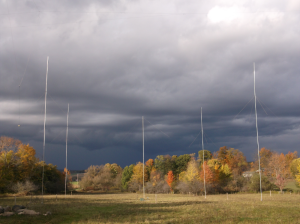Antenna Switch Desktop Controller
The desktop controller unit is the center of the receive switching and signal processing system. An embedded MPU is used to store all antenna, radio, and controller configurations, which is uploaded via RS232 from a PC and text file. Events (antenna selection change, gain adjustments, et.al.) are sent over an RS485 serial buss to slave units (switching modules, signal processing units, vertical array direction switching), providing synchronized control of a vast array of devices over a long range (up to 4000 ft).
 Each desk controller handles 2 receivers, an additional controller necessary for controlling devices for up to 4 receivers. Twelve buttons provide up to 36 functional selections through the use of TAP, TAP-TAP, and HOLD key presses.
Each desk controller handles 2 receivers, an additional controller necessary for controlling devices for up to 4 receivers. Twelve buttons provide up to 36 functional selections through the use of TAP, TAP-TAP, and HOLD key presses.
Ergonomics
Ergonomics were a consideration when designing a controller head capable of handling “unlimited” antenna selections. Clearly, per antenna buttons were not adequate and would severely limit the expandability of the system. Instead, optical encoders are used (one per receiver) for antenna selection navigation. The encoder state transitions are processed, with adjustable resolutions, to provide compass bearing navigation or list selection.
Configuration
The controller is configured with each antenna as both a physical entity as well as a virtual assignment (meaning a single physical antenna can be configured more than once as a different virtual antenna, ie. for assigning the same physical antenna to a different group). Antennas are additionally assign to groups, of which only a currently selected group is visible on the LCD panel (each half, ie. receiver, can independently select a valid group). Each group is assigned a selection mode, either compass or list. In compass mode, antennas are assigned bearing ranges and the selection knob (encoder) and LCD act as a rotor compass, selecting the appropriate antenna when traversing through bearings. List mode provides a list of antennas and is useful for non-directional or simple fixed arrays, ie. low dipoles, etc.
Features
- Up to 90 antennas (memory limited)
- Up to 10 groups
- Scanning mode within a group
- Realtime gain adjustment (in conjunction w/ signal processor unit)
- Bearing tracking between receivers (useful for diversity using different antenna groups)
- BCD Band decoding (automatically makes visible or hides “out-of-band” antennas/groups)
- Selection locking
- TX antenna selection
- Swap antennas
- Swap groups (maintain original bearing if in compass mode)
- Auxillary routing control (ie. NCC phase controller, used with signal processor unit)

